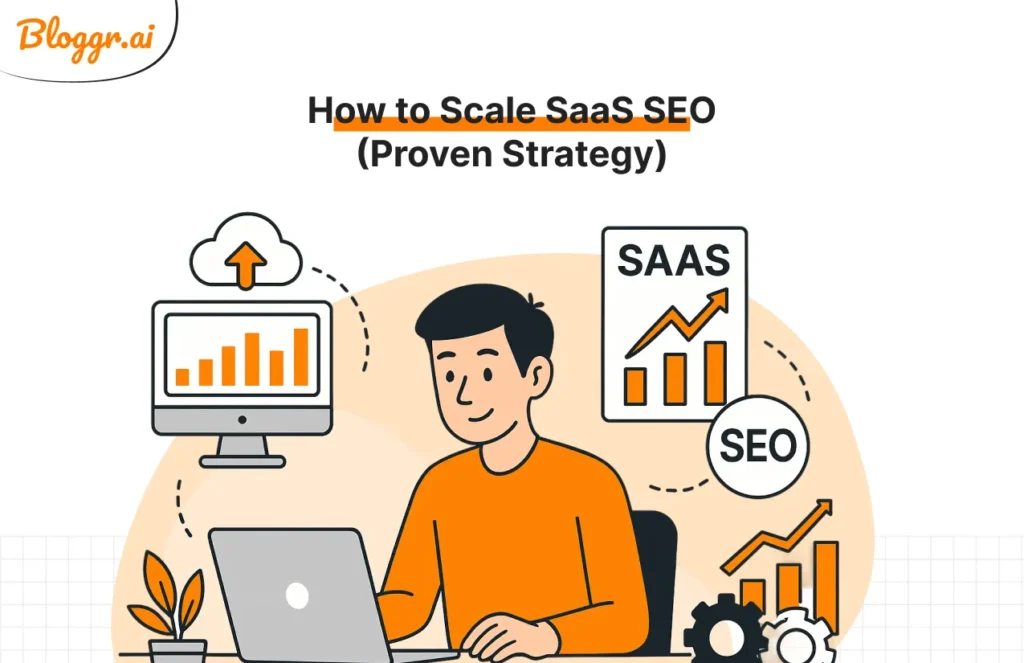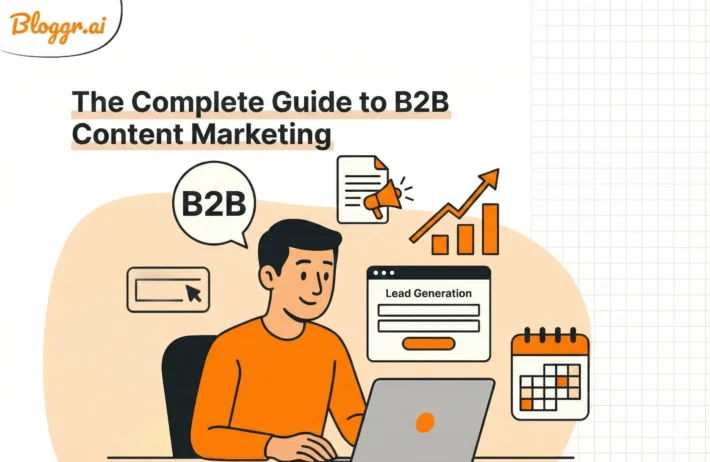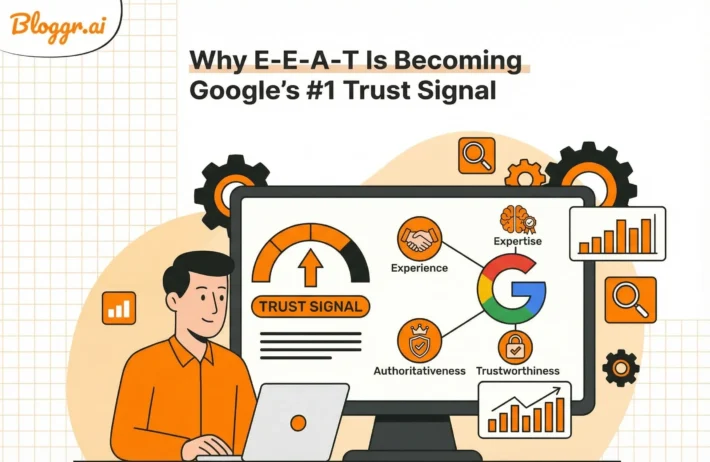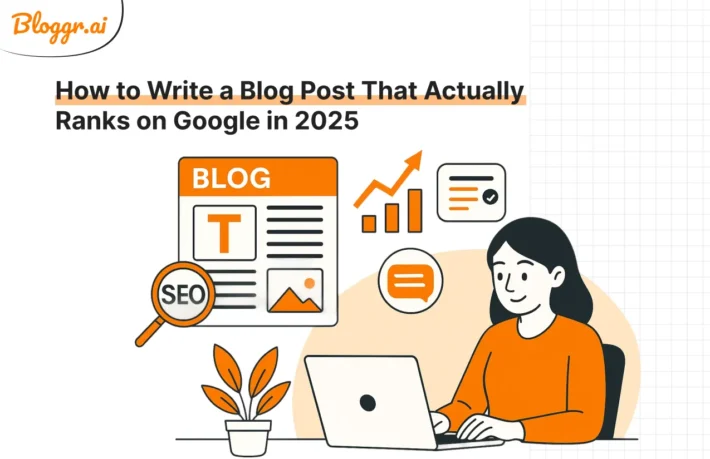How to Scale SaaS SEO – Strategies

TL;DR
- SaaS SEO drives high-intent users, focusing on trials, demos, and subscriptions rather than just traffic.
- Key strategies: target intent-driven keywords, create product-led content, optimize technically, and build backlinks.
- Avoid common mistakes: low-intent keywords, weak internal linking, ignoring technical SEO, and over-relying on blogs.
- Scale by auditing, setting goals, expanding content, tracking conversions, and continuously optimizing.
- Case study: Ahrefs grew from 0 → 3.4M visits using tutorials, feature content, free tools, and comparison pages.
Introduction
In the competitive SaaS landscape, relying solely on paid ads is costly and unpredictable. SEO remains one of the most sustainable and compounding growth channels. Unlike traditional SEO, SaaS SEO focuses on attracting high-intent users who are ready to sign up, start a trial, or request a demo. Tools like an AI Blog Writer can support content creation by helping generate well-structured, optimized articles that align with SEO goals.
This article provides a step-by-step framework to scale SaaS SEO, highlights common mistakes, and presents a real case study demonstrating measurable results.
What is SaaS SEO?
SaaS SEO refers to the specialized practice of optimizing a Software-as-a-Service (SaaS) website to attract, engage, and convert users through organic search traffic. Unlike traditional SEO, which may target e-commerce sites, blogs, or service-based businesses, SaaS SEO focuses on driving highly qualified leads to subscription-based software platforms. The goal is not just to drive traffic, but to acquire users who are likely to sign up for a free trial, demo, or paid subscription.
Key elements of SaaS SEO include:
- Targeting the Right Keywords – Focusing on intent-driven keywords like “best project management software” or “CRM software for small business” rather than generic terms.
- Content Strategy – Creating informative, problem-solving content that addresses pain points, guides decision-making, and builds authority in the niche.
- Technical SEO – Ensuring fast load times, structured data, proper indexing, and a seamless user experience that supports conversions.
- Conversion-Oriented Optimization – Optimizing landing pages, trial sign-up flows, and demo requests to turn organic visitors into paying users.
- Retention-Focused Approach – Unlike other industries, SaaS businesses thrive on recurring revenue, so SEO strategies also support customer retention by creating helpful resources, onboarding content, and feature updates.
You Should Know:
– What is Parasite SEO?
– What is Programmatic SEO?
– What is SEO for Dentists?
– Want is Enterprise SEO Tools
– SEO Newsletters Subscribe to
What Makes SaaS SEO Different from Traditional SEO?
SaaS (Software as a Service) SEO has unique characteristics that set it apart from traditional SEO strategies used for e-commerce, blogs, or service websites. Unlike regular SEO, which primarily focuses on driving traffic, SaaS SEO emphasizes acquiring qualified leads, retaining users, and increasing conversions over time. Here’s what makes it different:
| Factor | Traditional SEO | SaaS SEO |
| Goal | Traffic & visibility | Traffic → Trials → Revenue |
| Content Focus | General blogs & guides | Product-led content, use cases, alternatives |
| Keyword Strategy | Broad informational terms | High-intent, decision-stage keywords |
| Landing Pages | Static pages | Programmatic pages for features, integrations, and industries |
| Metrics | Clicks & rankings | Conversion rates, signups, and revenue attribution |
Quick Comparison On:
GEO vs SEO
Step-by-Step Strategy to Scale SaaS SEO
Scaling SaaS SEO requires a structured approach that targets both short-term wins and long-term growth. Here’s a step-by-step strategy to help SaaS businesses maximize organic traffic and conversions:
1. Perform a Comprehensive SEO Audit
Before scaling, understand your current SEO performance:
- Analyze keyword rankings, backlinks, and traffic sources.
- Identify technical issues like broken links, slow pages, or crawl errors.
- Review content performance to see which pages drive traffic and conversions.
2. Define Clear SEO Goals
Set measurable objectives aligned with your SaaS growth:
- Increase organic traffic by X% in 6 months.
- Improve lead generation through high-intent keywords.
- Boost domain authority with quality backlinks.
3. Develop a Targeted Keyword Strategy
SaaS SEO is unique because it targets both short-tail and long-tail keywords, making an effective SEO Keyword Strategy crucial for attracting high-intent users and driving sustainable growth
- Focus on keywords that reflect user intent at different funnel stages: awareness, consideration, and decision.
- Use tools like Ahrefs, SEMrush, or Google Keyword Planner to find high-potential keywords.
- Prioritize keywords with high commercial value and moderate competition.
4. Optimize On-Page SEO
Ensure every page is optimized for search engines and users:
- Optimize meta titles, descriptions, and headers with targeted keywords.
- Improve page structure, internal linking, and URL hierarchy.
- Use schema markup to enhance search visibility (e.g., FAQs, reviews, product schema).
5. Create High-Quality, Scalable Content
Content is the backbone of SaaS SEO, and creating a Topical Content Map ensures your strategy is organized, scalable, and effective. Here’s how to approach it:
- Develop pillar content that addresses core industry topics.
- Produce supporting cluster content targeting long-tail keywords.
- Incorporate data, case studies, and actionable insights to increase authority.
6. Implement a Link-Building Strategy
Backlinks are critical for SaaS domain authority:
- Reach out to industry blogs, tech publications, and SaaS review sites.
- Create shareable content assets like guides, infographics, and templates.
- Leverage partnerships, guest posts, and PR opportunities.
7. Focus on Technical SEO & Site Performance
Technical optimization ensures your site is crawlable and fast:
- Improve page load speed, mobile responsiveness, and site architecture.
- Fix crawl errors, broken links, and duplicate content issues.
- Use canonical tags and structured data to help search engines understand your content.
8. Leverage Analytics & Conversion Tracking
Monitoring and iterating is key to scaling:
- Track organic traffic, keyword rankings, and lead generation using Google Analytics and Search Console.
- Set up goals and events to measure conversions from organic traffic.
- Continuously test and refine content, CTAs, and landing pages for better performance.
Quick Comparison on:
Enterprise SEO ROI vs. Paid Ads ROI
9. Scale Content Production & Distribution
Once initial results show traction:
- Expand content topics, formats, and languages if relevant.
- Automate content promotion through email newsletters, social media, and SaaS communities.
- Repurpose high-performing content into videos, webinars, or infographics.
10. Continuously Optimize & Iterate
SaaS SEO is ongoing:
- Conduct quarterly audits to identify new opportunities.
- Update existing content to maintain relevance and improve rankings.
- Experiment with new SEO techniques, tools, and growth hacks to stay ahead of competitors.
“Mark your calendars! The top SEO conferences in 2025–2026 are coming — perfect for learning the newest tactics and networking with SEO experts.”
SaaS SEO Scaling Mistakes & How to Avoid Them
Scaling SaaS SEO can be highly rewarding, but it’s also riddled with common pitfalls that can slow growth or even harm your organic visibility. Understanding these mistakes—and how to avoid them- will help you implement a sustainable SEO strategy that truly drives results.
| Mistake | Impact | Fix |
| Targeting high-traffic but low-intent keywords | Traffic without conversions | Focus on BOFU and pain-point keywords |
| Publishing blogs without internal linking | Lost authority & UX issues | Build content clusters with internal links |
| Ignoring technical SEO | Slow ranking improvements | Optimize Core Web Vitals & page speed |
| Relying only on blogs | Slow signups | Include comparison, feature, and template pages |
SaaS Brand That Scaled SEO from 0 to 3.4M Visits (Ahrefs Case Study)
Ahrefs achieved massive growth without paid ads, demonstrating the power of structured SEO:
| Tactic | Result |
| In-depth tutorials | Attracted relevant marketers |
| Feature-led content | Ranked for transactional keywords |
| Free tools like Keyword Generator | Drove sticky organic traffic |
| Comparison pages | Converted undecided users |
This illustrates that authority-driven, product-led SEO compounds significantly over time.
Conclusion
SaaS SEO is a high-impact growth channel that drives qualified leads, user retention, and recurring revenue. By auditing your site, optimizing content and technical elements, building backlinks, and tracking performance, SaaS businesses can scale sustainably. Focus on high-intent keywords, avoid common pitfalls, and iterate consistently to make SEO a reliable engine for signups and revenue.
People Also Asking About SaaS SEO
Q1: How long does it take to scale SaaS SEO?
A: 4–6 months for traction; 12+ months for compounding growth, depending on content velocity and authority.
Q2: What content works best for SaaS SEO?
A: Comparison pages, templates, alternatives, tutorials, and case studies typically outperform general blog posts.
Q3: Should SaaS companies outsource SEO or build in-house?
A: Start with strategy & execution via an agency, then gradually build internal SEO processes.
Q4: Can AI automate SaaS content creation?
A: AI can help with research, drafts, and outlines, but human expertise is needed for accuracy and trust.
Q5: Is link building necessary for SaaS SEO?
A: Yes — prioritize high-quality backlinks from authoritative sources using PR, research, or product-led content.
Q6: How do you measure SaaS SEO success?
A: Focus on signups, trial conversions, feature page engagement, and revenue attribution, not just traffic.


